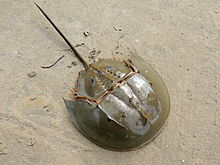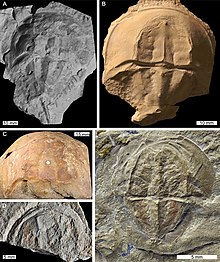| Limulidae Temporal range:
| |
|---|---|

| |
| Tachypleus gigas, one of the four extant species | |

| |
| Jurassic-aged limulids. Crenatolimulus (A,B), Limulus (C), Mesolimulus (D,E) | |
| Scientific classification | |
| Domain: | Eukaryota |
| Kingdom: | Animalia |
| Phylum: | Arthropoda |
| Subphylum: | Chelicerata |
| Order: | Xiphosura |
| Superfamily: | Limuloidea |
| Family: | Limulidae Leach, 1819[1][2] |
| Genera | |
|
See text | |
Horseshoe crabs are arthropods of the family Limulidae and are the only surviving xiphosurans. Despite their name, they are not true crabs or even crustaceans. Rather, they are chelicerates. This makes them more closely related to arachnids like spiders, ticks, and scorpions. The body of a horseshoe crab is divided into three main parts: the cephalothorax, abdomen, and telson. The largest of these, the cephalothorax, houses most of the animal's eyes, limbs, and internal organs. It is also where the animal gets its name, as its shape somewhat resembles that of a horseshoe. Horseshoe crabs have changed little in appearance since they first evolved in the Triassic, earning them the title of "living fossil".
Only four species of horseshoe crab are extant today. Most are marine, though the mangrove horseshoe crab is often found in brackish water. Additionally, certain extinct species transitioned to living in freshwater. Horseshoe crabs primarily live at the water's bottom but they can swim if needed. In the modern day, their distribution is limited, only found along the east coasts of North America and South Asia.
Horseshoe crabs are often caught for their blood, which contains Limulus amebocyte lysate, a chemical used to detect bacterial endotoxins. Additionally, the animals are used as fishing bait in the United States and eaten as a delicacy in some parts of Asia. In recent years, horseshoe crabs have experienced a population decline. This is mainly due to coastal habitat destruction and overharvesting. To ensure their continuous existence, many areas have enacted regulations on harvesting and established captive breeding programs.
| External videos | |
|---|---|
 | |
- ^ Sekiguchi K (1988). Biology of Horseshoe Crabs. Science House. ISBN 978-4-915572-25-8.
- ^ "Limulidae Leach, 1819". World Register of Marine Species. Flanders Marine Institute. 2023. Archived from the original on 26 April 2023. Retrieved 17 January 2023.